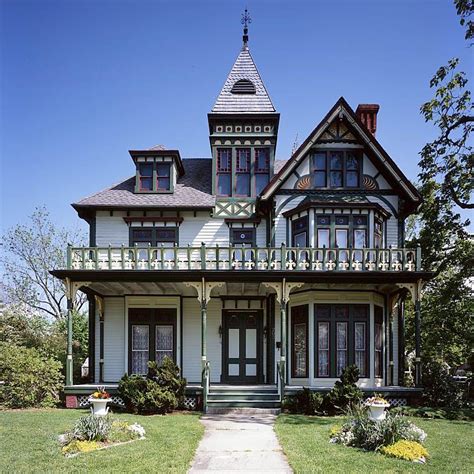The Queen Anne style, a quintessential architectural phenomenon of the late 19th and early 20th centuries, is characterized by its eclectic blend of medieval and classical elements, intricate detailing, and a pronounced emphasis on ornamentation. Emerging during the reign of Queen Victoria, this style found its peak popularity in the United States and Britain, reflecting the societal aspirations of the time towards elegance, sophistication, and historical reverence.
At its core, the Queen Anne style is a celebration of complexity and layering, with homes often featuring a combination of materials and textures, such as brick, stone, wood, and slate. The façades of these homes are a visual feast, adorned with patterned masonry, half-timbering, and an array of windows that vary in size, shape, and placement, from dormer windows to bay windows and oriel windows. This diversity in window design not only adds to the aesthetic appeal but also significantly enhances the interior with natural light and views.
One of the defining features of Queen Anne homes is their asymmetrical façade, which breaks away from the symmetrical layouts of earlier architectural styles. This asymmetry is often accentuated by the judicious placement of turrets, towers, and projecting wings, creating a dynamic, almost whimsical, silhouette that is both visually striking and highly individualized. The use of turrets, in particular, serves a dual purpose, providing not only a touch of romanticism but also functional space, often utilized as cozy reading nooks or libraries.
The interior of Queen Anne homes is as striking as their exteriors, reflecting the emphasis on comfort, elegance, and the display of the owner’s wealth and taste. Interiors are often characterized by grand entry halls with sweeping staircases, richly ornamented fireplaces, and intricately carved woodwork. The living spaces are designed to be opulent yet intimate, with built-in cabinetry, paneling, and an attention to detail that speaks to the craftsmanship of the era. The emphasis on decoration extends to every aspect, from the intricate plasterwork ceilings to the bespoke furnishings, each element contributing to an atmosphere of refined luxury.
Despite their grandeur, Queen Anne homes also incorporate elements of practicality and innovation, reflecting the evolving lifestyle needs of the Victorian era. For example, many of these homes feature modern plumbing, central heating, and spacious kitchens designed for the new middle-class lifestyle that emphasized domesticity and entertainment. The incorporation of such amenities, alongside their aesthetic appeal, contributed to the enduring popularity of the Queen Anne style, as it catered to both the desire for historical significance and the need for modern comforts.
In terms of historical context, the Queen Anne style is a significant reflection of the social, economic, and cultural shifts of the late 19th and early 20th centuries. It emerged during a period of industrial growth and urbanization, where the rising middle class sought to express its newfound status through architecture. The style’s emphasis on historical elements and handmade craftsmanship also speaks to the reaction against the mass production and uniformity that characterized the Industrial Revolution. Furthermore, the Queen Anne style’s focus on individuality and customization resonated with the societal values of uniqueness and self-expression.
Today, Queen Anne homes remain highly coveted for their unique blend of historical charm, architectural complexity, and the sense of community they evoke. They are a testament to the enduring appeal of traditional craftsmanship and the allure of a bygone era. For those interested in purchasing or restoring a Queen Anne home, it is essential to approach the project with a deep respect for the original craftsmanship and historical integrity of the property, while also considering the needs and comforts of modern living.
Restoration and Modernization
Restoring a Queen Anne home to its original glory is a complex and nuanced process, requiring a delicate balance between preserving historical integrity and incorporating modern amenities. It involves meticulous research to identify original materials and techniques, alongside a thoughtful approach to updating systems and spaces for contemporary living. One of the primary challenges is finding a harmony between the preservation of the home’s historical elements and the introduction of modern comforts and technologies.
For instance, updating the electrical and plumbing systems while maintaining the original architectural details can be a daunting task. It requires careful planning and execution to ensure that the modernization does not compromise the home’s historical character. Similarly, introducing energy-efficient solutions, such as double-glazed windows or solar panels, must be done in a way that respects the original design and materials of the home.
Practical Tips for Restoration
Conduct Thorough Research: Before initiating any restoration work, it is crucial to conduct thorough research on the home’s history, including its original construction, any previous restorations, and the materials used. This research will provide valuable insights into the home’s architectural style, historical significance, and the techniques used in its construction.
Consult with Experts: Collaborating with architects, historians, and contractors who specialize in period homes can provide invaluable guidance on how to navigate the complexities of restoration. These experts can offer advice on everything from preserving original materials to introducing modern amenities in a way that is consistent with the home’s historical character.
Preserve Original Materials: Whenever possible, original materials such as woodwork, doors, and hardware should be preserved and restored rather than replaced. This not only maintains the home’s historical integrity but also ensures that the restoration is true to the original design and craftsmanship.
Balance Preservation and Modernization: The key to successfully restoring a Queen Anne home is finding a balance between preserving its historical elements and introducing modern comforts and technologies. This requires careful consideration of how to update systems and spaces without compromising the home’s original character.
Conclusion
Queen Anne homes represent a pinnacle of architectural expression, blending historical reverence with the practical needs of modern living. Their enduring appeal lies not only in their aesthetic beauty and the craftsmanship that went into their creation but also in the sense of community and historical continuity they provide. As we continue to appreciate and restore these architectural gems, it is essential to approach each project with sensitivity, respect, and a deep understanding of the cultural and historical context in which they were created.
FAQ Section
What are the key characteristics of a Queen Anne home?
+Queen Anne homes are characterized by their asymmetrical façades, use of multiple materials and textures, such as brick, stone, and wood, intricate detailing including patterned masonry and half-timbering, and a variety of window styles and placements. They often feature turrets, towers, and projecting wings, contributing to their dynamic and highly individualized silhouettes.
How do I restore a Queen Anne home while maintaining its historical integrity?
+Restoring a Queen Anne home requires meticulous research into its original construction and materials, consultation with experts, and a thoughtful approach to updating systems and spaces. It is essential to preserve original materials whenever possible and to balance preservation with the introduction of modern comforts and technologies in a way that respects the home’s historical character.
What are some practical tips for modernizing a Queen Anne home?
+Practical tips for modernizing a Queen Anne home include conducting thorough research on the home’s history, consulting with experts, preserving original materials, and finding a balance between preservation and modernization. It is also important to consider the introduction of energy-efficient solutions and modern technologies in a way that is consistent with the home’s historical character.



